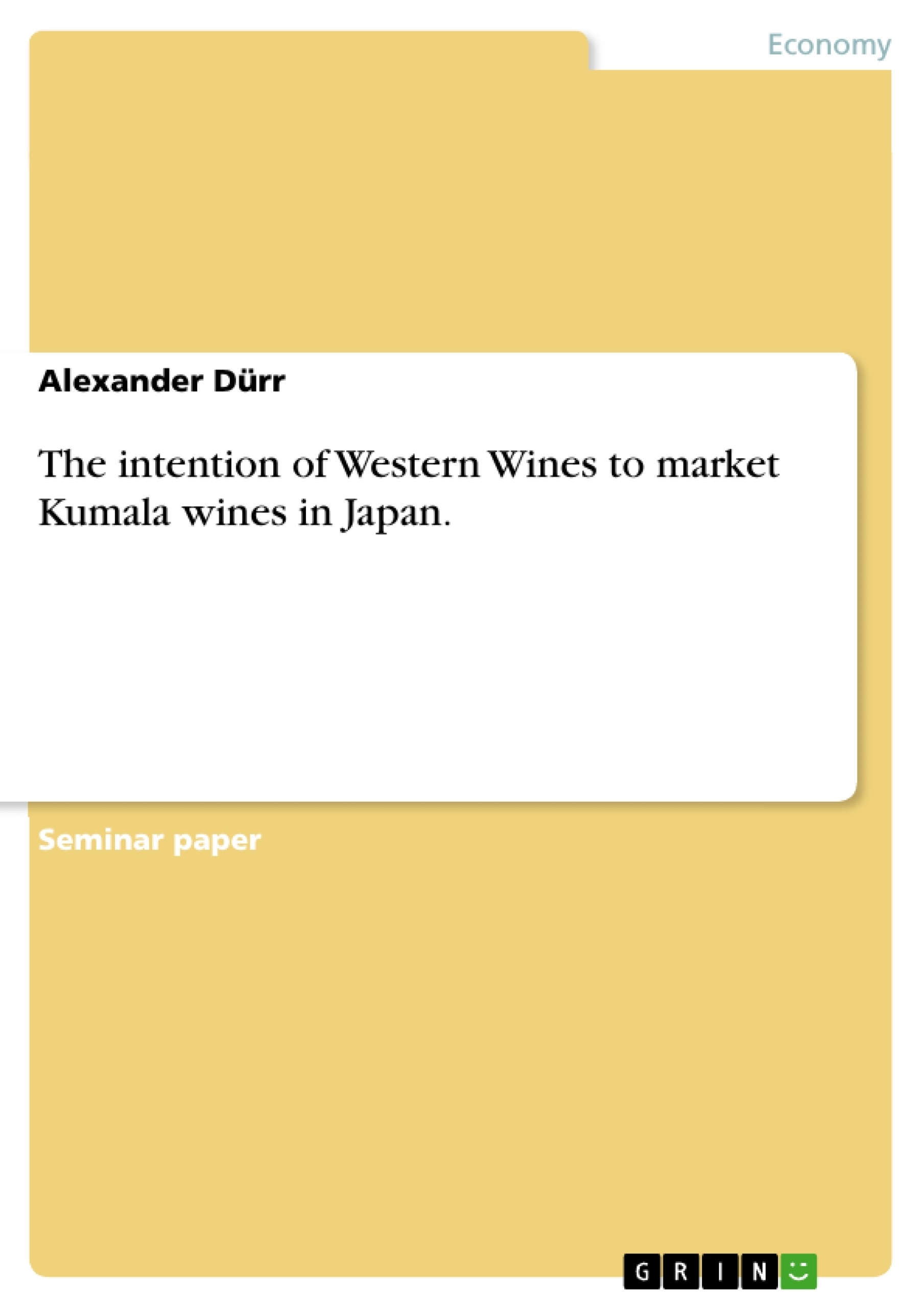Extrait
Table of Contents
Abstract
1. Kumala Wines
2. Marketing Environment (SLEPT-Analysis)
3. Market Opportunity Analysis
3.1 Competitive Environment
3.2 Consumer Analysis
4. Market Entry Strategy
5. Marketing Mix11
5.1 Product
5.2 Price
5.3 Place
5.4 Promotion
6. Conclusion
Bibliography
Appendix
This work will analyse the intension of Western Wines to market Kumala wines in Japan. The report is fundamentally structured into five parts: First there will be given a short introduction about Kumala Wines and their product range. The second part give the most important facts against an entry in Thailand and South Korea and contains a detailed marketing environment analysis of Japan, as the most favourable country to launch Kumala`s products. After that it will continue with analysing possible opportunities and threats for Kumala`s range in the chosen market. The next section will focus on an initial market entry strategy for Kumala developed on the data of the analysis. Based on the points above the fifth part will contain a marketing mix proposal. In the end their will be a short conclusion. Throughout the whole paper relevant marketing concepts are used and applied. The work is based on secondary research to a large extent.
illustration not visible in this excerpt
1. Kumala Wines
Kumala Wines (South Africa) is a brand which is owned by Western Wines and was launched in 1995. The family-owned company Western Wines UK was established in 1980 and is the largest privately owned wine importer in the UK. The company has a annual turnover of £ 100 million and handles more than 10% of total SA wine export worldwide. (Superior Beverages, 2004)
Kumala wines are grown and bottled in South Africa (Stellenbosch).
The product range contains a variety of white, red and rose wines.
The price ranges from £ 4.49 to £ 14.99. Basically they are producing for the upper medium-class market.
The aim of Kumala wines is to produce wine with the consistency of quality and the drinkability of the “New World” while keeping its South African identity. (Superior Beverages, 2004)
Kumala is the biggest South African and 4th largest wine brand in the UK with 25 million bottles sold in 2003. Furthermore it is the number 1 exported wine from South Africa going to approximately 25 countries round the world. (Superior Beverages, 2004)
Kumala describes its ABCI customer as 24 - 54 years old and more innovative and adventurous in terms of choosing wine. (Kumala, 2004)
(further details see Appendix 1)
2. Marketing Environment Analysis
While evaluating how to contribute to the sector’s competitiveness, it is crucial to look beyond the challenges and key questions faced by individual firms and instead considers issues that affect all firms. One mechanism for making such an evaluation is through a “SLEPT” analysis. A SLEPT analysis is a country-specific analysis of quantitative and qualitative external macro-environment that affects all firms. “S.L.E.P.T.” is an acronym for the S ocial, L egal, E conomic, P olitical and T echnological factors. (Doole, I. & Lowe, R., 2001) These external factors are usually beyond the firm's control and often times present themselves as threats.
Although there are some good points about the markets of South Korea and Thailand it seems to be Japan as the most favourable country for the companies aim. The decision for Japan and against Thailand and South Korea is based on some important points:
- The consumption of wine per capita in Thailand is less than a litre (0.07 l in 2001) per year (compared to 60 litres in Europe or 3 litres per head in Japan) (Institute of Alcohol Studies, 2004)
- Both duty and tax are 60 % which means that Thailand`s tax on wine accounts for about 81 % of the retail cost of a bottle. (e. g. an imported $ 10 bottle of wine would end up costing $ 52) (Bangkok Post, 2001)
- Alcohol is a major public health problem in Thailand. Therefore the government brought in new legislation to cut alcohol consumption and reduce harm caused by alcohol (warning labelling, restriction for alcohol advertisement). (Institute of Alcohol Studies, 2004)
- French wine is clearly dominating the South Korean market. (55.4 % market share) The word “French” is synonymous with “wine” in the Korean consumers minds. (United States Department of Agriculture, 2004)
- Distribution in Korea is fragmented and inefficient; only a few companies provide a national distribution system; importers must usually deal with many distributors to gain full national coverage. (Australian Trade Commission, 2004)
- Australia as a “New world” wine producing country is penetrating the South Korean market to a high extent. Their traditional good trade relationships and their geographical location to South Korea gives them strong advantage and major incentives (e. g. Free Trade Agreement) (Austrade, 2004)
(further details see Appendix 2)
In the following the Japanese market will be analysed in more details.
illustration not visible in this excerpt
[...]
- Citation du texte
- Alexander Dürr (Auteur), 2004, The intention of Western Wines to market Kumala wines in Japan., Munich, GRIN Verlag, https://www.grin.com/document/55948
Devenir un auteur






















Commentaires